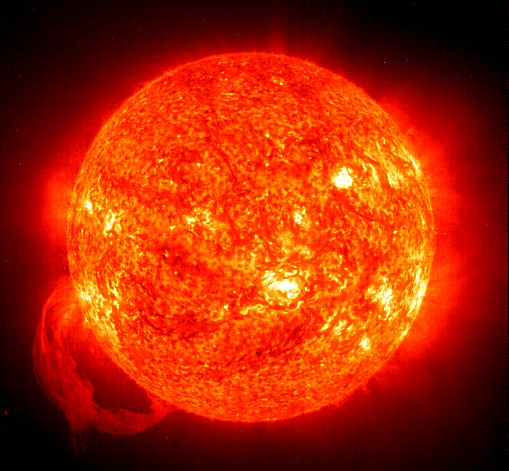The Sun and Nuclear Fusion
|
"The Sun, with all the planets revolving around it, and depending on it, can still ripen
a bunch of grapes as though it had nothing else in the Universe to do." ~ Galileo

Mass: 1.989x1030 kg Radius: 695,000 km (equator) Mean Density: 1.410 gm/cm3 Rotation Period: 25 - 36 days Escape Velocity: 618.02 km/sec Luminosity: 3.839 x 1026 watts Magnitude (Vo): -26.8 Surface Temp: 5,780 K (mean) Age: 4.5 billion years
In the core of the Sun hydrogen is being converted into helium. This
is called nuclear fusion. It takes four hydrogen atoms to fuse into each helium atom.
During the process some of the mass is converted into energy.
Mass of 4 H atoms: 4.03130 AMU Mass of 1 He atom: 4.00268 AMU 1 Atomic Mass Unit (AMU) equals 1.67x10-27kgs The difference between the mass of 4 H atoms and 1 He atom is 0.02862 AMU which is only 0.71% of the original mass. This small fraction of the mass is converted into energy. If 4 grams (1/8 ounce) of H are converted to He, only 2.8x10-3 grams of the mass is converted to energy: How much energy is generated from converting such a tiny amount of mass? We can calculate by using Einstein's famous formula. E = mc2 E = (2.8x10-3 grams) x c2 E = (2.8x10-6 kgs) x (3x108m/sec)2 E = 2.6x1011 joules Enough energy to keep a 60-watt light bulb shining for over 100 years! The Sun has different layers with different properties, these layers are composed of material that is about 75% hydrogen and 25% helium by mass. Simply put, the Sun is a great ball of gas, hot enough to glow in every tier. In the very innermost part of the Sun, called its core, the temperature is about 15 million Kelvins, the density is 150 times that of water, and the pressure is over 200 billion times greater than atmospheric pressure here on Earth. This heavy, sweltering place is where the Sun's energy is produced via a process known as thermonuclear fusion. While fusion is difficult to mimic on Earth, the core of the Sun and other stars is a perfect environment for it. Here, the temperatures are high enough for hydrogen nuclei to smash together and form helium nuclei, releasing tremendous amounts of energy in various forms. Energy produced in the form of light keeps bouncing around inside the Sun, as though the Sun were made entirely of mirrors. A particle of light can take more than 30,000 years to reach the surface and escape! Energy in the form of small particles called neutrinos, however, can travel directly out of the Sun and into the Solar System. Neutrino observatories on Earth measure the continual wash of these tiny, fast-moving particles. The apparent visual magnitude of the Sun is -26.8, making it appear about 10 billion (10,000,000,000) times as bright as the next brightest star, Sirius. The absolute magnitude of the Sun, the magnitude it would have at a distance of 10 parsec or 32.6 light years, is +4.8. Among the brightest stars we can see with the naked eye, there is only one, alpha Centauri, with a comparable absolute magnitude to the Sun. Most of the rest are intrinsically far brighter. Light takes about 500 seconds (8 1/3 minutes) to travel from the Sun to the Earth. The average distance to the Earth from the center of the Sun is about 149,000,000 km, or 93,000,000 miles; a distance known as an astronomical unit (AU). There are over 63,000 AU in 1 light year. 1 AU is about 0.000016 light year. The nearest star, alpha Centauri, is 4.3 light years distant, or about 280,000 AU.  Activity on the solar surface, photo by Brad Snowder. |